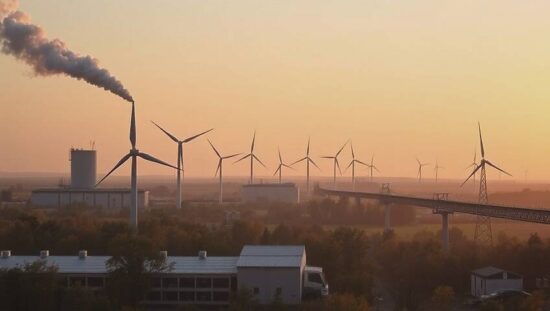Germany’s power generation is as CO2-light as never before, due to the increasing share of renewable energies and the decline of coal-fired power generation. This is evident from an evaluation presented by the Fraunhofer Institute for Solar Energy Systems ISE on Thursday. Since 2014, the CO2 emissions from power generation have halved, from 312 to around 152 million tons per year. The CO2 emissions of German power generation were thus 58 percent lower than at the beginning of the data collection in 1990.
According to the research institute’s evaluation, wind power was also the most important power source in 2024, contributing 136.4 TWh or 33 percent to public power generation. 2024 was a weaker wind year than 2023 (139 TWh). The share of onshore wind power decreased to 110.7 TWh (2023: 115.9 TWh), while offshore production was slightly above the previous year’s level at 25.7 TWh (2023: 23.5 TWh).
The expansion of wind energy remains significantly behind the plan: By November, 2.4 gigawatts (GW) of new onshore capacity had been built, with a planned 7 GW. The expansion of offshore facilities performed better than in previous years, with 0.7 GW of new capacity built in 2024 (planned 5-7 GW per year until 2026 and 30 GW by 2030).
Solar power plants produced around 72.2 TWh in 2024, of which 59.8 TWh was fed into the public grid and 12.4 TWh was used for self-consumption, according to the study. The overall production increased by around 10.8 TWh, or 18 percent, compared to the previous year. Its share in public grid power generation was 14 percent. The month of July 2024 was the one with the highest solar power generation, at 10.3 TWh.
The expansion of solar power in 2024, as in 2023, exceeded the government’s targets: Instead of the planned 13 gigawatts, a total of 13.3 gigawatts had been built by November. By the end of 2024, it is expected to reach 15.9 gigawatts. The solar power expansion in Germany remains on a two-digit level.
Hydro power, according to Fraunhofer, generated around 21.7 TWh, roughly the same as in the previous year (19.1 TWh). The installed capacity of run-of-river power plants is 6.4 GW, and the installed capacity of biomass power plants remained unchanged at 9.1 GW, generating 36 TWh of power.
In total, the renewable energies in Germany generated around 275.2 TWh of power in 2024, which is 4.4 percent higher than in the previous year (267 TWh). The share of renewable energies in the German power mix, i.e., the power that actually comes out of the socket, was 56 percent, up from 55.3 percent in 2023.





